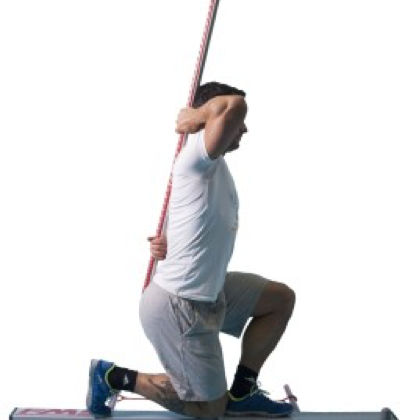Forms of endurance training
Endurance training involves placing large muscle groups under strain for longer periods at a time. Such exercise mainly affects the respiratory and cardiovascular systems and, at the muscle level, the stamina of the muscle groups used. The aerobic element of endurance exercise can be divided into three different forms of training efficiency: basic endurance, tempo endurance and maximum endurance. Anaerobic endurance is also called lactic speed endurance. In order to improve your endurance, you need use all forms of training.
Aerobic fitness is important because the underlying physiological variables, systems and processes are highly versatile. The efficacy of endurance exercise can be evaluated by heart rate. Target heart rate levels are usually expressed as a percentage of the maximum heart rate.
The improvement of aerobic condition is based on many factors and their interdependence. These factors include heart rate and functional capacity, oxidative (i.e. aerobic) enzymatic activity in the muscles, energy metabolism efficiency and economy, maximum oxygen uptake, muscle power output, lactic acid removal capacity and muscle energy.
Aerobic training is also restorative and nurturing for the body. The better the aerobic base, the easier the body flushes out lactic acid. This is of great relevance for the form and rhythm of the training.
The goal of basic endurance training is to increase the aerobic threshold and improve fat utilization in energy generation. Basic endurance training increases and opens up the capillaries and thus improves the ability to transfer oxygen to the tissues. Basic endurance training can be divided into BE1, BE1-2 and BE2 training. These all require effort to put the heart rate within the range of 50%–70% of the heart rate maximum.
BE1 training is ‘under-speed training’, where the heart rate is at the lower end of the endurance heart rate. BE1-2 is normal basic endurance training, where the heart rate varies across the entire basic endurance range. BE2 training is known as aerobic threshold training, where the heart rate and power used are very close to the aerobic threshold or even on it.
Basic endurance training should be continuous and long-term. Most training takes place in the basic endurance area, and it is good to remember that even strenuous sprints include basic endurance phases. Regardless of level, all endurance athletes need pure aerobic training. The effectiveness of aerobic exercise is not based solely on its duration; regularity and a sufficient frequency of training are also important. The benefit of a run does not end when you return to your home – the increased metabolic state it causes can be long lasting.
A common mistake is to overestimate your own level and perform BE training that is too hard. Light exercises done too vigorously or hard exercises done too gently cause a common problem with endurance exercises. If light and restorative BE exercises are done with too much power, they will become stressful and the body will not be able to recover from the training. In this case, the training will quickly become too hard.

Basic endurance training
The duration of basic endurance exercises can vary from 30 minutes to several hours. The exercise is usually long-lasting and continuous. Basic endurance properties can also be developed by increasing the length of the warm-up and cool-down and by increasing the number of daily runs, for example, by adding in a morning run.
The quality of training
High-quality training is often misunderstood as intensive training. However, as basic endurance training is the form of training that is most practiced in endurance training, the high-quality implementation of basic endurance training should be prioritised. As an example, in a long cycling session exercise efficiency often drops towards the end of the session, even though the heart rate remains the same. To ensure the effectiveness of the training when cycling, it is advisable to use a power meter, if possible.
In order to obtain sufficient benefit from a long endurance exercise session, the efficiency of the exercise must be at least maintained throughout the session, but ideally there should be a slight increase in power towards the end of the session, while remaining below the aerobic threshold. The importance of quality also applies to technique. If the trajectories in the basic training are carried out incorrectly and without constant control, the same mistakes will also occur at a high speed when fatigue is present. If the training is carried out in a progressive way and with good technique, muscular endurance will develop much better than if there is a loss of power towards the end of the session.
Considerations for the practical implementation of endurance training:
- Basic endurance training should be carried out as endurance exercises
- Efficiency should not fall towards the end of the session, but increase
- Concentrate on good technique
- Remember to replenish fluids and energy. This will improve recovery and the ability to complete the exercises
- At the beginning of the training period, it is important to remember that even if your metabolism might allow you to complete a long training session, your muscles may not be up to it
- Remember to control the increase in the basic endurance level (aerobic threshold) with the training
Basic endurance period
Basic fitness is built with gentle aerobic exercise. For summer sports enthusiasts, the basic season lasts from autumn to the end of the winter, while for skiers the basic endurance season begins after the racing season in spring and early summer. For ordinary keep-fit enthusiasts, a clear basic endurance season is recommended. Many fitness enthusiasts practice and compete in different sports in different seasons, which poses challenges to training and programming.
In order to increase fitness, it is advisable to expand the range of sports you participate in. A runner benefits from cycling and skiing, and a skier can easily expand his/her training regime with cycling. Although BE training is a major part of the basic endurance period, it is good to keep the training versatile. Light exercise allows you to undertake a large number of workouts and prepare your body for more strenuous training and racing. However, tempo, anaerobic and muscle strength training should be kept in the programme during the basic endurance training period. Sharp and fast-paced sprints will enliven the plentiful slow-paced training sessions.
It is advisable to do speed and tempo training exercises in addition to long basic endurance training sessions. However, these should not be too long in order to maintain the aerobic balance and the main purpose of the exercise. A long workout improves muscular and metabolic fitness, as well as economy of movement, and therefore such exercises have a direct impact on the development of competition technique. Before undertaking tempo endurance training, you should cultivate your basic endurance. Your performance will not improve in the long run if your aerobic base is poor. Steady-paced exercise is the best method for developing tempo endurance, because then the strain remains constant.
Tempo endurance is the most important
Tempo endurance is an important feature in all types of endurance sport and over all distances. Improving your results requires discipline-specific performance, i.e. tempo endurance. In addition to basic fitness, it is an important part of the body’s aerobic capacity, a kind of store of fitness that is necessary for long-lasting performance. Tempo endurance training develops the body’s carbohydrate metabolism, which is needed for high-intensity performance. It also teaches economy. Tempo endurance training plays an important role in the development of oxygen uptake. Tempo endurance training occurs far below the maximum endurance level, but it still develops the skill and power required for fast performances. Tempo endurance requires a very fast and strenuous level of speed, so a high-intensity session also develops mental determination. The heart rate limits are generally 70%–85% of the maximum heart rate.
Training for tempo endurance
Tempo endurance exercise can be carried out either as one steady session or in intervals. A steady-paced workout would be a continuous sprint of at least 15 minutes. At its longest, a tempo endurance session can take an hour for an experienced athlete.
For example, it is common to perform two 20-minute tempo endurance sprints within the session, with a 10-minute recovery period between. The first sprint is often made in the tempo endurance 1 area, i.e. closer to the aerobic threshold, and the second sprint in the tempo endurance 2 area, i.e. at the anaerobic threshold. A common problem with tempo endurance exercises is that the intensity hits the maximum endurance range. Special attention should be paid to conditions and terrain changes during exercise.

Intensive exercises
Tempo endurance sessions strain the body. You should have one or two lighter training days before and after a tempo endurance session in order to optimally prepare for it and allow enough time for recovery. It is not advisable to do a tempo endurance exercise if you’re tired. For an active trainer, tempo endurance training is best done a maximum of twice a week. An adequate goal for a fitness-enthusiast is one tempo endurance exercise per week.
Considerations for the practical implementation of tempo endurance training:
- Find out your thresholds (aerobic and anaerobic) to be able to train at the correct intensity. Take note of the differences in your thresholds in different disciplines.
- Tempo endurance training at too high a speed in relation to your own fitness level can easily cause straining if the intensity is wrongly estimated.
- Other muscles cannot cope with endurance training as well as the cardiac muscle, so remember to gradually increase the exercise intensity.
- Track your development in all tempo endurance exercises if possible.
- Remember to warm-up and cool-down thoroughly.
- Longer-lasting tempo endurance exercises are often safer to implement than short interval-type exercises.
- Remember to carry out tempo endurance exercises of varying intensity throughout the year.
- You should easily be able to increase the pace in your tempo endurance training.
Maximum endurance
Depending on the individual, the anaerobic threshold is about 85%–90% of the maximum heart rate. At this point the yield and the output of lactic acid are still in balance. Maximum endurance exercise is performed above the anaerobic threshold.
Maximum endurance training is usually carried out as an interval-type exercise (e.g. 5 x 4 minutes) or as one session (e.g. 15 minutes). Each interval should be at least three minutes long in order to ensure sufficient aerobic activity occurs. In addition, the heart rate must reach the plateau phase at certain constant power and remain there for at least two minutes in order for the training to develop aerobic endurance properties.
The goal of maximum endurance training is to develop maximum aerobic efficiency. At the same time, the training prepares the body for the stress of competitions. Maximum endurance exercise can be carried out as part of a competition, either in your own sport or in another discipline. Maximum endurance training does not need to be part of the training programme every week, but should feature at least 1–2 times a month for maintenance, preferably throughout the training period. You need to be fully focused when undertaking maximum endurance exercises, as they are ultimately exercises that directly improve the qualities required for competition.
Maximum endurance training
Maximum endurance training is often misunderstood. It never really means full speed. If you want to develop maximum endurance properties, the sprint must be evenly paced or should accelerate towards the end. Heart rate alone is not necessarily a reliable metric, because if the initial pace is too high, the heart rate may remain high until the end of the sprint, even if the pace or power output drops significantly.
Maximum endurance training always requires a careful warm-up and cool-down. The warm-up should increase in intensity and, before starting the maximum endurance exercise, should reach the tempo endurance range. It is a good idea to start the cool-down from the aerobic threshold if you want to lower your lactate levels as quickly as possible.
Sensible start
At the beginning of the training period, hardly any maximum endurance training will have been carried out. The same formula of progression applies to maximum endurance training as to other training. At the beginning, the body is easily stimulated, thus training should be light and easy, and progress quickly and easily achieved. At this point maximum endurance training can be fitted into the programme with two 4–5 minutes sprints just above the anaerobic threshold. This will provide a stimulus for both metabolism and muscles that increases performance.
Considerations for the practical implementation of maximum endurance training:
- One maximum speed sprint must be at least 3 minutes long.
- Recovering from maximum endurance training takes significantly longer than recovering from basic or tempo endurance training.
- Warm-ups for maximum endurance training should increase in intensity; in other words, maximum endurance training also contains tempo endurance at the beginning.
- Maximum endurance training always requires at least a 20-minute warm-up and cool-down session.
- The intensity must not decrease towards the end of the sprint, nor in each set.
- Progress and the stress state of the body should always be monitored during maximum endurance exercise.





